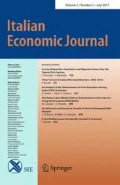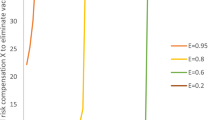Abstract
While it reduces the probability of facing a primary (or vaccine-preventable) disease, vaccination may also introduce the risk of facing vaccine induced side effects. In this paper, we address the link between this feature of vaccination and attitudes toward risk. Risk aversion is shown to increase the propensity to vaccinate when the primary disease is lethal or when the risks of primary disease and of side effects are faced in different periods. When the primary disease is non-lethal and may occur together with side effects, we show how the effect of risk aversion is affected by the probability and severity of each disease. The implications of the introduction of random effects of primary disease and of random side effects are also analyzed.





Similar content being viewed by others
Notes
In this direction, the model in this work can be seen as a kind of extension of self-protection models where the cost of self-protection is to face a new risk. On this see also the discussion in Sect. 7.
Starting from Menegatti (2009), the two-period framework is alternatively used in the literature on self-protection against financial risks.
This is also the typical case of vaccines against influenza which usually have short-term side effects and are distributed before the expected period of contagion.
In fact, Pauker and Kassirer’s treatment is similar to the self-insurance instrument while vaccination acts as self-protection.
A special case of this reduction, where p = \( \Delta \), is considered in the paper by Nuscheler and Roeder (2016), since they study eradication of the primary disease.
Note that in the case where \( q = 0 \) we would just have that, under our assupmption, the decision maker vaccinates for every positive \( \Delta \).
We emphasize that the results obtained in the following sections hold under alternative formulations of the assumptions introduced in this section on how vaccination affects the probability of contracting the primary disease and on how primary and secondary diseases worsen the health status. For instance, it can be easily shown that replacing \( p - \Delta \) with \( p \) (where \( < 1 \)) or replacing \( H_{0} - M_{1} \) with \( m_{1} H_{0} \) and \( H_{0} - M_{2} \) with \( m_{2} H_{0} \) (where \( 0 < m_{1} < m_{2} < 1) \) does not affect the results derived in next sections.
This is another and less fundamental difference between vaccination and the self-protection literature. In the latter, the decision maker has to select a level of self-protection while for vaccination the decision maker may face a binary decision (vaccinate or not) or decisions involving a finite number of consequences (depending for instance on the use of vaccine adjuvants). Also note that our assumption on agent’s decision implicitly implies that vaccination is voluntary. For a discussion on recommendations versus mandates in vaccination see, for instance, Lawler (2017).
Note that under quadratic utility the mean value theorem ensures that \( u\left( y \right) - u\left( z \right) = u^{\prime } \left( s \right)[y - z] \) where \( s = \frac{y + z}{2} \).
References
Basch CH, Zybert P, Reeves R, Basch CE (2017) What do popular YouTube™ videos say about vaccines? Child Care Health Dev 43(4):499–503
Blaisdell LL, Gutheil C, Hootsmans NAM, Han PKJ (2016) Unknown risks: parental hesitation about vaccination. Med Dec Mak 36:479–489
Bleichrodt H, Crainich D, Eeckhoudt L (2003) The effect of comorbidities on treatment decisions. J Health Econ 22:805–820
Brianti M, Menegatti M, Magnani M (2017) “Optimal choice of prevention and cure under uncertainty on disease effect and cure effectiveness. Res Econ. https://doi.org/10.1016/j.rie.2017.03.005
Brito D, Sheshinski E, Intriligator M (1991) Externalities and compulsory vaccinations. J Public Econ 45:69–90
Courbage C, Rey B (2006) Prudence and optimal prevention for health risks. Health Econ 15:1323–1327
Courbage C, Rey B (2016) Decision thresholds and changes in risk for preventive treatment. Health Econ 25:111–124
Ehrlich I, Becker G (1972) Market insurance, self-insurance, and self-protection. J Polit Econ 80:623–648
Fabry P, Gagneur A, Pasquier JC (2011) Determinants of A (H1N1) vaccination: cross-sectional study in a population of pregnant women in Quebec. Vaccine 29(9):1824–1829
Fadda M, Allam A, Schultz PJ (2015) Arguments and sources on Italian online forums on childhood vaccinations: results of a content. Vaccine 33:7152–7159
Felder S, Mayrhofer T (2014) Risk preferences: consequences for test and treatment thresholds and optimal cutoffs. Med Decis Mak 34:33–41
Freimuth VS, Jamison A, Hancock G, Musa D, Hilyard K, Crouse Quinn S (2017) The role of risk perception in flu vaccine behavior among African-American and white adults in the United States. Risk Anal. https://doi.org/10.1111/risa.12790
Gargano LM, Painter JE, Sales JM, Morfaw C, Jones LM, Murray D et al (2011) Seasonal and 2009 H1N1 influenza vaccine uptake, predictors of vaccination, and self-reported barriers to vaccination among secondary school teachers and staff. Hum Vaccine 7(1):89–95
Gaygisiz U, Gaygisiz E, Ozkan T, Lajunen T (2010) Why were Turks unwilling to accept the A/H1N1 influenzapandemic vaccination? People’s beliefs and perceptions about the swine flu outbreak and vaccine in the later stage of the epidemic. Vaccine 29:329–333
Geoffard P-Y, Philippson T (1997) Disease eradication: private versus public vaccination. Am Econ Rev 87:222–230
Lawler EC (2017) Effectiveness of vaccination recommendations versus mandates: evidence from the hepatitis a vaccine. J Health Econ 52:45–62
Liu D, Menegatti M (2019) Optimal saving and health prevention. J Econ. https://doi.org/10.1007/s00712-018-00652-6
Liu L, Rettenmaier AJ, Saving TR (2009) Conditional payment and self-protection. J Risk Uncertainty 38:159–172
Maurer J (2015) Inspecting the mechanism: a longitudinal analysis of socioeconomic status differences in perceived influenza risks, vaccination intentions, and vaccination behaviors during the 2009–2010 Influenza Pandemic. Med Decis Mak 36:887–899
Menegatti M (2009) Optimal prevention and prudence in a two period model. Math Soc Sci 58:393–397
Menegatti M (2014) Optimal choice on prevention and cure: a new economic analysis. Eur J Health Econ 15:363–372
Murphy TV, Gargiullo PM, Massoudi MS et al (2001) Intussusception among infants given an oral rotavirus vaccine. N Engl J Med 364:564–572
Myers LB, Goodwin R (2011) Determinants of adults’ intention to vaccinate against pandemic swine flu. BMC Public Health 11(15):1–8
Nuscheler R, Roder K (2016) To vaccinate or to procrastinate? That is the prevention question. Health Econ 25:1560–1581
Patel MM, Richardson Lopez-Collada V, Mattos Bulhoes M et al (2011) Intussusception risk and health benefits of rotavirus vaccination in Mexico and Brazil. N Engl J Med 364:2283–2292
Pauker SG, Kassirer JP (1975) Therapeutic decision making: a cost-benefit analysis. N Engl J Med 293:229–234
Rainey JJ, Watkins M, Ryman TK, Sandhu P, Bo A, Banerjee K (2011) Reasons related to non-vaccination and under-vaccination of children in low and middle income countries: findings from a systematic review of the published literature, 1999–2009. Vaccine 29:8215–8221
Rheinberger CM, Herrera-Araujo D, Hammitt JK (2016) The value of disease prevention vs treatment. J Health Econ 50:247–255
Smith LE, Webster RK, Weinman J, Amlôt R, Yiend J, Rubin GJ (2017) Psychological factors associated with uptake of the childhood influenza vaccine and perception of post-vaccination side-effects: a cross-sectional survey in England. Vaccine 35:1936–1945
Thompson EL, Rosen BL, Vamos CA, Kadono M, Daley EM (2017) Human papillomavirus vaccination: what are the reasons for nonvaccination among US adolescents? J Adolesc Health 61:288–293
Tsuchiya Y, Shida N, Izumi S, Ogasawara M, Kakinuma W, Tsujiuchi T, Machida K (2016) Factors associated with mothers not vaccinating their children against mumps in Japan. Public Health 137:95–105
World Health Organization (2017) Report of the World Health assembly global vaccine action plan. World Health Organization, Geneva
Yaari ME (1987) The dual theory of choice under risk. Econometrica 55:95–115
Author information
Authors and Affiliations
Corresponding author
Additional information
Publisher's Note
Springer Nature remains neutral with regard to jurisdictional claims in published maps and institutional affiliations.
Rights and permissions
About this article
Cite this article
Crainich, D., Eeckhoudt, L. & Menegatti, M. Vaccination as a trade-off between risks. Ital Econ J 5, 455–472 (2019). https://doi.org/10.1007/s40797-019-00089-w
Received:
Accepted:
Published:
Issue Date:
DOI: https://doi.org/10.1007/s40797-019-00089-w




